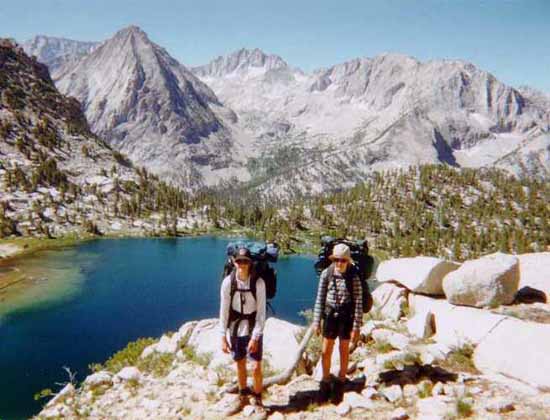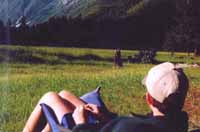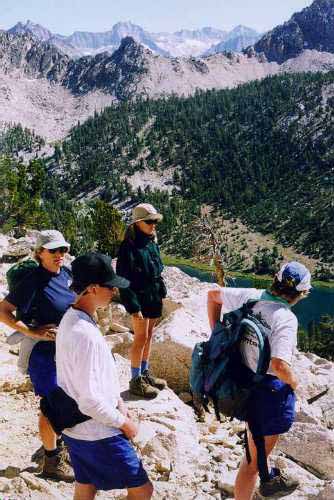Sierra Nature Notes, Volume 2, June 2002
Family
Nature Explorations — A Resource Kit
by Michael Elsohn Ross
A long-time Yosemite resident and environmental educator, Michael has authored
a number of children's books on natural history.
 |
| Whether a gentle stroll on a trail or a more challenging backcountry hike, kids can have a great and rewarding adventure with the right preperation. |
Going on a nature exploration with kids is always an adventure. Children have a natural curiosity, which constantly leads them into discoveries. Parents, grandparents, and other adults who explore nature with kids can support youthful inquiry by being equipped with some handy resources.
Kid
Hikes in Yosemite
Yosemite, for instance, has hundreds of miles of trails, but where are the
best places to walk with young people? Hiking with kids can be a challenge,
but a pocket size guide to hiking, Easy Day Hikes in Yosemite, provides
all the information for choosing the best routes. The guide lists everything
from the ever-popular Vernal Falls trail to lesser-known strolls such as Lukens
Lake, McGurk's Meadow, and the Merced Grove of Big Trees. A good rule of thumb
for hiking with children is to make their first adventures easy enough to
accomplish, but still a bit of a challenge. Even toddlers can manage a flat
mile walk. Just be prepared to stop often and have plenty of snacks and drinks
available. It is also wise to carry a map of the area you choose to hike in.
A whole array of maps are available that cover different segments of the park.
The Happy Camper Handbook has a great section of basic hiking tips
and comes with a flashlight and rescue whistle that kids can carry in their
pack.
 |
| Time for quiet contemplation is important on any fun trip. |
Trail
Explorations
Children easily make discoveries along the trail. They find bugs, animal burrows,
pinecones, and flowers. Even if you are a novice naturalist you can expand
children's awareness by encouraging them to use their senses more fully. Try
some of these simple activities:
Besides being pretty, each flower has unique colors and patterns. What
colors or designs can you see? Make a game out of seeing how many colors or
shapes you can see on a walk. Count the number of petals on a flower or legs
on a bug.
Explore with
your nose. Sniff pine bark, flowers, and leaves. Feel the world with your
fingers. Test the temperature of a stream or lake. Sit quietly in the forest
and feel around you with your eyes closed.
Tune in your ears. Listen carefully in a place far enough from the
road that you can hear bird songs and other sounds. With your eyes closed
count how many different sounds you can hear.
Each of these experiences will deepen your park experience. In
addition you can also teach park stewardship. For example explain that collecting
pines cones, arrowheads, or other cool items is against park rules for a good
reason. It's important to leave these potential collectibles for other kids
to find when they walk the same trail.
Exploration
Tools
A
variety of tools will help your kids be better explorers.
 |
The
World of Small, Nature Adventures with a Hand Lens
This handy book comes equipped with a bright blue magnifying lens
and ideas for discovering the miraculous worlds of tree bark, ground moss,
bugs, dirt, rocks, flowers, and much more. Just turn the pages to reveal one
eye-popping activity after another.
Greet
a Tree
Many adults feel a bit like dummies when it comes to telling one tree from
another. Lucky for us there is a great little guide titled the Pacific
Coast Tree Finder that turns this uncomfortable situation into a fun
game. Though decoding tree names using a plant key can be a frustrating
experience,
the tree finder makes it as easy as it can get. (Which probably will be easier
for your kids than for you!).
On Track
Kids are sharp observers and often notice animal tracks in snow, mud, or the
sandy shores of a pond or creek. A little detective work using the Audubon
Society Pocket Guide to Familiar Animal Tracks of North America is exciting,
especially if they confirm that those size 12 feet belong to a local black
bear!
Binoculars
An economy model is just fine for kids to use as long as they are clean and
in relatively decent shape. Large birds such as raven, robins, and jays often
stay in one place long enough to fix your binoculars on them. Climbing to
the top of a mountain or the bottom of a valley is infinitely easier through
the lens of binoculars than your own two feet. Tasco, Bushnell, and Swift
all make adequate entry level binoculars. Magnifications of at least 7 or
8 are best for young people who might have difficulty keeping a 10 power pair
steady enough to get a clear view.
Back
in Camp (or room)
After a long day on the trail you may be ready for a siesta, but the kids
might still have plenty of energy left. You can keep them on path to exploration
by letting them play games or color the pages in the Yosemite Fun Book. Listening
to Yosemite by Song on CD or cassette is a great way to learn a bit more
about Yosemite as well as add a new repertoire of tunes to your campfire
fare. For story time Two Bear Cubs is a fun Miwok tale that explains the
origin of El Capitan. For the older kids Legends of the Yosemite Miwok offers
some authentic, and at times a bit gruesome, stories. For classic adventure
stories you can’t
go wrong with a few chapters or choice passages from The Wild Muir. This collection
of some of John Muir’s most entertaining writing includes everything
from his near fatal climb near Yosemite Falls to his adventures with the
little dog Stickeen in Alaska.
The items listed above are some of the most useful ones for supporting a self-guided expedition with kids. Collect some of them bit by bit, and before long your kids will be teaching you.
Further Reading
Tracks,
Scats and Signs (Take-Along Guide)
by Leslie Dendy, Linda Garrow (Illustrator)
With this Take-Along Guide you will learn how to spot, and identify, common
clues that 17 wildlife species leave behind in the woods, in the fields and
along ponds. It's a fun way to turn everyday walks into exciting mysteries.
And make you a nature detective!
Online hiking guide to Sequoia and Kings Canyon National Parks
Kid's Activities in Sequoia and Kings Canyon National Parks
Check out all Kid's Books at the Yosemite Association Bookstore
General Tips for Hiking with Kids
Tips for hiking with kids
(with thanks to Dorothy Greco, mother of three):
• Apply sunscreen, and supply a hat.
• Be sure to pack snacks and plenty of liquids. Avoid caffinated beverages. Salty treats will replenish liquids lost to sweat better than sweet things.
• Honor their limits. Rest when they need to. Turn back before you planned if necessary. Pushing a child beyond his/her physical limit will not be fun for anyone.
• Before you go, show them photos of plants and animals they might see along the way. Help them "see" acorns, leaves, flowers, and animal prints. Some kids might enjoy bringing a small pad of paper and pencils so they can draw what they see.
• Many children will be motivated by a special something at the end of the hike; a waterfall, unusual rock formation, or pretty picnic spot.
• Be alert to trail traffic. If possible, choose hiking-only trails to avoid conflicts with cyclists and equestrians. If you hike a multi-access trail, be sure your children are acquainted with trail etiquette.
• Before your trip, choose a strategy for bathroom needs. Bring soap and a towel to clean up.
• In the San Francisco Bay Area, check out tips for hiking around San Francisco at Bay Area Moms.
Our Founder Questions? Go to About Our New Site |
Masthead
Photo from: |